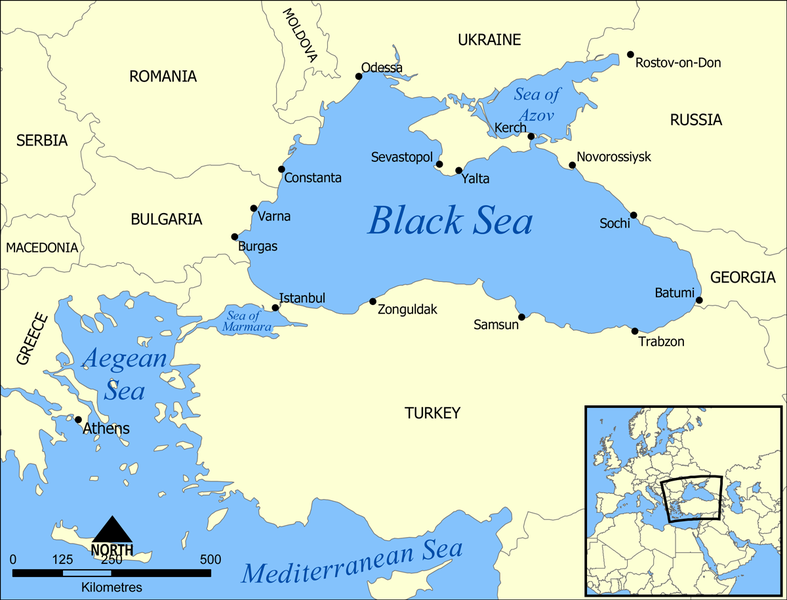Black Sea
From CruisersWiki
Contents |
BLACK SEA CRUISING GUIDE
An online cruising guide for yachts sailing in the Black Sea.
Background
The Black Sea (Greek: Μαύρη Θάλασσα or Εύξινος Πόντος, Turkish: Karadeniz) is an inland sea between southeastern Europe and the Anatolian peninsula Turkey and is ultimately connected to the Atlantic Ocean via the Mediterranean and Aegean Seas and various straits. The Bosporus Strait connects it to the Sea of Marmara, and then the long island-bound strait of the Dardanelles connects it to the Aegean Sea region of the Mediterranean. These waters separate eastern Europe and western Asia. The Black Sea also connects to the Sea of Azov by the Strait of Kerch. The Black Sea has an area of 436,400 km² (168,495 sq mi), and a maximum depth of 2,200 m (7,200 ft).
In his wonderful book Neal Ascherson describes the unusual conditions of the Black Sea. The Black Sea receives the waters of five major rivers: the Kuban, the Don, the Dnieper, the Dniester and above all the Danube. These rivers deposit a tremendous amount of organic matter. Over thousands of years the bacteria feeding on this matter exhausted the oxygen at the lower depths of the Black Sea, creating a condition known as anoxia. In its stead, the oxygen has been replaced by the deadly hydrogen sulfide (H2S). So, today the Black Sea consists of two layers separated by a well-defined boundary called haloclyne or oxyclyne. This boundary is at a depth of about 200 m, below which the water is infused by H2S and is totally devoid of life. Above the oxyclyne however, the surface layer of the Black Sea is teaming with life and fish. This abundance of fish has made the coastal area very wealthy. There are many dolphins in the Black Sea which delight the sailor.
The Black Sea basin was colonized by the Greeks as early as the Bronze age. The legend of the Argonauts in search for the Golden Fleece originates from that period. Mycenaean anchors have been found all along the coast of the Black Sea. Later in the antiquity many Greek coastal colonies had been established around the sea trading with their founding mother cities dried fish and later wheat and timber. The Greek presence in the Black Sea, or the Pontos, continued until the early part of this century.
Recent theories have linked the formation of the Black Sea with the biblical legend of the Flood. According to this theory the Black Sea was originally a fresh water lake. Then, 7,600 years ago, the melting of the glaciers flooded the Mediterranean. This extra water, eventually cut a narrow channel, the Bosphorus, and salt water flowed into the Black Sea at the rate of 10 cubic miles per day for two years. This deluge caused the waters in the Black Sea to rise at the rate of six inches per day and covered all the coastal human habitations. Robert D. Ballard, the discoverer of the Titanic, is leading an expedition, based in Sinop, to investigate this theory. The Institute of Nautical Archaeology, under the leadershp of the pioneering underwater archaeologist George Bass, is also interested in future work in the Black Sea waters.
Charts
- BA 2214 The Euxine or Black Sea
- NIMA 55100 Western Part of the Black Sea
- NIMA 55105 Eastern Part of the Black Sea
- Turkey 10A Western Blacksea
- Turkey 10B Eastern Blacksea
Radio Nets
Submit details of local radio Nets.
Weather
General weather contitions?
Sources for weather forecast information:
Countries (and Ports)
Entry/Exit
Islands and Groups
List Islands & Island Groups (pages will be made for each)
Passages
Popular passages & best timing, etc.
Forum Discussions
List links to discussion threads on the Cruiser Log Forum
References & Publications
- Rick and Sheila Nelson, Black Sea Cruising Guide, Imray Laurie and Wilson, Cambridgeshire, ISBN 0852881738
- Neal Ascherson, Black Sea, Hilll & Wang, New York, ISBN 0809015935
- Mariana Koromila, Pontos - Anatolia, Fotographico odiporiko (in Greek), Brazioti, Athens
- Tim Severin, The Jason Voyage, the Quest for the Golden Fleece, Hutchinson, London, ISBN 0091618800
External Links
- Black Sea (Wikipedia)
Personal Notes
.
